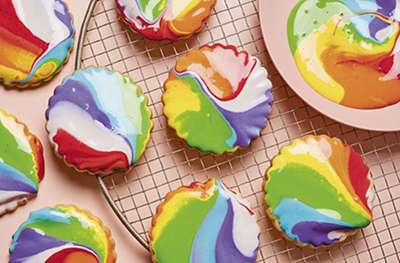0 added
Item price
£2.65Price per unit
£2.65/kg
Edd Kimber's marbled biscuits are a fun weekend baking project. You can choose how many colours to use in the icing and how to swirl them together, but Edd's preference is for the full rainbow, with a little white to make them pop. The technique takes a bit of practice but the results are worth it. The biscuits are delicious, however they’re decorated!
Please note, we take every care to ensure the product, allergen and recipe information displayed is correct. However, should a product be unavailable, alternatives may be displayed and/or a substitution provided. If you have an allergy or intolerance, please always check the product label before use.
Put the icing sugar, flour and salt in the bowl of a food processor and pulse until combined. Add the butter and pulse until the mixture resembles breadcrumbs. Add the egg yolks and vanilla, then whizz for about 2 minutes, until evenly combined. Tip the mixture out onto a work surface and use your hands to bring together into a uniform dough. Wrap the dough and press into a flat disc; chill for 20 minutes.
Line a baking tray with parchment. Lightly flour a work surface and roll out the dough until it is about 0.5cm thick. Use a 5cm fluted biscuit cutter to cut out as many rounds as possible, transferring them to the lined baking tray. Gather the dough scraps together, press together and re-roll to cut out more biscuits. Chill the biscuits for 20 minutes. Preheat the oven to 160ºC, gas mark 3. Bake the chilled biscuits for 12-15 minutes, until golden around the edges and a touch paler in the centre. Allow to cool on the tray.
For the icing, put the egg whites and a pinch of salt in a large bowl and use electric beaters to beat until frothy. Add the sugar, a little at a time, while continuing to beat, until combined and smooth. Add the vanilla and almond extract; beat briefly to combine. Scrape the icing into 7 small bowls. Add a few drops of colouring to 6 of the bowls and mix it in. (For purple, you’ll need to add a little blue and red.) Stir a few drops of lemon juice into each bowl to ensure the icing is thick but runny; it should be sitting flat in each bowl.
Spoon a little white icing onto a small plate, followed, in a circle, by a little of each colour, in order of the rainbow if desired (so white, red, orange, yellow, green, blue, purple). Dip a biscuit into the icing and rotate it about 90º to your left to create a rainbow swirl, then lift the biscuit out of the icing. Allow any excess icing to drip off the biscuit before inverting and setting back onto the baking tray to set, icing-side up. Repeat with the remaining biscuits – you should get 2 or 3 dips from each batch of icing before you need to repeat the process with a new plate. (This icing technique means you will end up with excess icing but you can keep it in the fridge for up to 3 days and use it to decorate cupcakes or other biscuits.) Once the icing has set, you can store the biscuits in a sealed container for up to 4 days.
Typical values per item when made using specific products in recipe
Energy | 681kJ/ 162kcals |
|---|---|
Fat | 5.6g |
Saturated Fat | 3.3g |
Carbohydrates | 26g |
Sugars | 18g |
Fibre | 0.5g |
Protein | 1.8g |
Salt | 0.2g |
Book a slot to see product availability at your nearest Waitrose & Partners store
0 added
Item price
£2.65Price per unit
£2.65/kg0 added
Item price
85pPrice per unit
56.7p/kg0 added
Item price
£1.90Price per unit
£5.43/kg0 added
Item price
£2.25Price per unit
£9/kg0 added
Item price
£3.65Price per unit
60.8p each0 added
Item price
£4.00Price per unit
£6.16/100g0 added
Item price
£3.65Price per unit
60.8p each0 added
Item price
£2.65Price per unit
£2.65/kg0 added
Item price
£4.00Price per unit
£6.16/100g0 added
Item price
£2.00Price per unit
£5.27/100ml0 added
Item price
£1.25Price per unit
£5/litre0 added
Item price
£1.85Price per unit
3.9p each